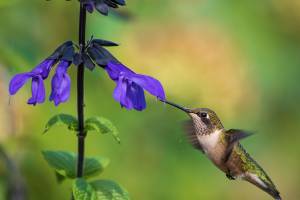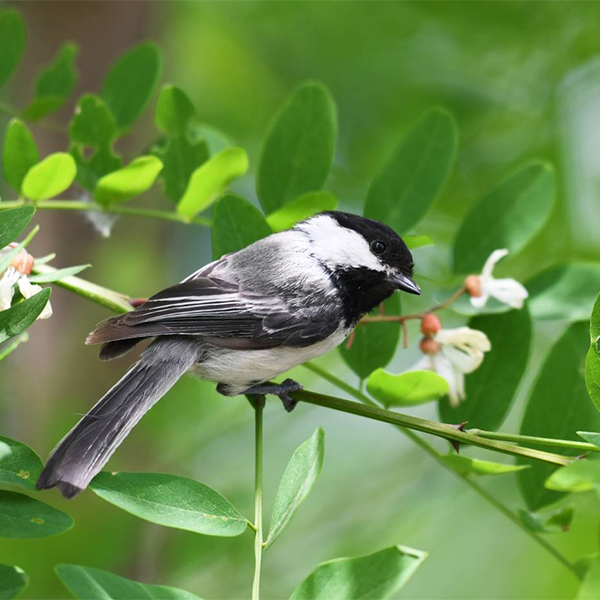You can easily convert an outdoor space—large or small—into a bird-friendly landscape by adding a few important habitat elements.
The benefits of creating an avian haven may surprise you. Not only will you attract birds, but you’ll also make your property more inviting for people and animals!
Why Landscape for Birds?
Here are three good reasons to create a welcoming place for wildlife:

You’ll see more birds.
Many of us use feeders to attract birds. By providing additional places for birds to take shelter and nest, you’ll keep them around, so that there’s so much more to observe and enjoy.
You’ll help save wildlife.
One-quarter of the land in Massachusetts is residential development. Turning yards, gardens, and parks into bird-friendly landscapes adds important habitat to these areas and could help save backyard birds like house wrens, whose numbers are declining in the state.
You’ll benefit people, too.
A bird-friendly yard is an inviting place for you to sit and relax, and for kids to explore and learn. By preserving natural diversity, you’ll be helping to protect your community’s resources.
How to Landscape for Birds
The key to bird-friendly landscaping is to look at what birds need across all parts of their life:
Food
Different types of birds need different foods, from buds to seeds to insects to nectar, and their diets often vary throughout the year. Never use pesticides, because these will destroy many non-target species, and even pest species can provide good food for the birds. To attract a variety of species, give birds plenty of choices. Here are some suggestions, and you can also contact your local garden center.
- Conifers: Evergreens provide both food and shelter for birds. The cones hide seeds that many species are adept at extracting and others bear fruit, especially important during winter months. Look for native pines, spruces, junipers, cedars and arborvitae.
- Nut-bearing Trees: Many nuts (also called “mast”) are popular with woodpeckers, jays, titmice, and turkeys. Spring blossoms attract insects, providing food for spring arrivals. Consider oaks, hazels, beeches, butternuts, chestnuts, buckeyes, hickories and walnuts.
- Summer Fruits: Fruit makes up a large portion of the diet of many species, and supplements the diet of nestlings as well. Look for cherry, chokecherry, raspberry, blueberry, grape, elderberry, native honeysuckle and native mulberry.
- Autumn Fruits: Birds count on plentiful food in the fall, whether for migration or to fatten up for the winter. Dogwood, bayberry, serviceberry, mountain ash, cotoneaster and buffaloberry are good choices.
- Winter Fruit: Some fruits don’t become palatable to birds until they have frozen and thawed several times, keeping these available for late winter eating. Choose among Virginia creeper, crabapple, snowberry, sumac, viburnum, Eastern wahoo, highbush cranberry, and winterberry.
- Grasses: Many native grasses are planted for landscaping, but don’t cut them back in the fall as their seeds can provide food for the birds. Look at wavy hair grass, prairie dropseed, switchgrass, little bluestem, pink muhly grass, purple love grass, big bluestem, and Indian ricegrass
- Perennials: Coneflower, Jerusalem artichoke, sunflower, coreopsis, black-eyed Susan provide seeds in the fall that attract finches and sparrows.
- Nectar: Hummingbirds and orioles are attracted to nectar producing flowers, but especially those with tube-shaped blooms. Consider trumpet creeper, beebalm, trumpet honeysuckle, cardinal flower, assorted salvia, and columbine.
Water
Fresh water is essential for both drinking and bathing. Install a birdbath (on the ground, or on a pedestal if predators are frequent), and clean it regularly using a solution of one part bleach to nine parts water. Make sure to rinse the bath thoroughly before refilling.
Many birdbaths are made too deep. Small birds prefer shallow water (i.e., anything under 2 inches). To rectify this, add gravel to the bath or place a small branch in the water with one end resting on the rim and the other in the water so that birds can move along the branch to the water depth they prefer.
In winter, you can keep the water from freezing by either refilling often or using a bath heater. Never use glycerin, which is toxic if ingested and can destroy the insulating properties of feathers. Learn more about birdbaths and how to maintain them.
If space permits, a small in-ground pond in the corner of the yard, with plenty of protective cover around it, is the most attractive to birds. Small pumps can be purchased to circulate the water since moving water has been proven to be especially attractive to birds.
Cover
Birds need protection from weather and predators. Provide cover with low shrubs and dense plants like evergreens. To create many places to hide, balance large trees with smaller shrubs, and evergreens with deciduous plants. You can also construct brush piles from plant clippings.
Cats Indoors
Keep your yard wildlife friendly by keeping your cat indoors. It’s better for wildlife, and better for the cats, too.
Nesting sites
A mix of plants will help different species find their preferred nesting spots. When it’s safe, leave dead trees and branches in place for cavity nesters like woodpeckers and bluebirds. If you’re using birdhouses, try installing several sizes and locations. You’ll be rewarded with a lively mix of birds.
From MassAudubon.org








